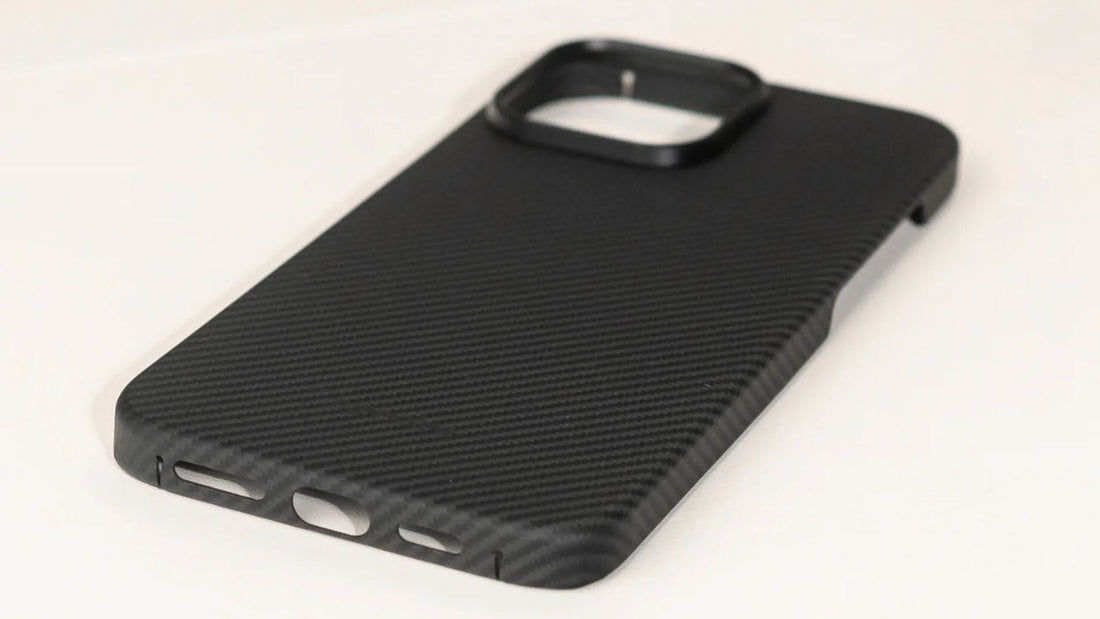
Why Use Ultra-Thin iPhone 16 Pro Max MagSafe Case vs Regular Case
Share
Cases and accessories have come a long way. From mere protective shells, they became our helpful everyday companions. With the introduction of the iPhone 16 Pro Max, the accompanying improvements in MagSafe technology have enhanced user experience in significant ways.
Likewise, the improvements in MagSafe technology make it stay relevant, considering the various devices it is integrated into, such as the iPhone 16 series, Apple Watch, AirPods, wireless chargers, and a pool of good third-party magnetic accessories.
Speaking of which, the power of MagSafe has become as versatile as ever. There are now many options besides Apple's standard MagSafe cases and accessories, including the ultra-thin iPhone 16 Pro Max aramid fiber case.
But what about our regular cases that came before? In this blog, we'll explore the differences between the iPhone 16 Pro Max MagSafe case vs regular case, and help you determine which aligns best with your lifestyle and preference.
Table of Content
What Is MagSafe?

MagSafe was initially introduced as a safety feature for MacBook charging cables, but it has since evolved into a system that supports a wide range of accessories for the iPhone. This magnetic system features a ring of magnets around the iPhone’s charging coil, allowing users to easily attach charging accessories as well as non-charging items like wallets and mounts.
For the iPhone 16 models, Apple has updated the MagSafe charger with a 30W adapter, enabling 25W wireless charging, faster than the 15W speeds of both Qi2 and the previous MagSafe charger.
The choice between the iPhone 16 Pro Max MagSafe case vs regular case ultimately comes down to personal preference and daily needs. Below, we’ve provided a comparison to help you understand the differences between these two types of cases.
Comparison: Ultra-Thin iPhone 16 Pro Max MagSafe Case vs Regular Case
You need a case if you don’t want to risk your iPhone 16 Pro Max to scratches, dents, or a shattered screen. But which one do you choose? Let’s break down the key differences.
1. Thickness and Weight
Ultra-thin MagSafe cases are designed to add minimal bulk to the iPhone 16 Pro Max while still keeping that magnetic touch. Typically measuring less than 1mm in thickness, they preserve the iPhone’s premium profile and make it easy to handle, so it’ll fit comfortably in pockets or small bags.
A 600D aramid fiber case or Kevlar is unbeatable in this department– materials that offer exceptional strength and durability while remaining unbelievably thin.
In contrast, regular cases have a lot to choose from. Some are designed with rugged materials for sturdy protection, while others are so flimsy they’ll break in just one drop.
2. Protection Levels
The primary function of any phone case is to protect the device from potential damage. Ultra-thin MagSafe cases offer basic protection against scratches, minor scuffs, and daily use. However, their slim design might not provide substantial cushioning against significant drops or impacts.
Meanwhile, regular cases, especially those designed for rugged use, often incorporate multiple layers of protective materials such as silicone, polycarbonate, or even metal. They are engineered to absorb shocks and safeguard the device from more severe impacts.
3. Aesthetic and Design
Ultra-thin MagSafe cases maintain the iPhone 16 Pro Max’s (or any device's) original aesthetics, allowing the design to shine without obstructions. It’s also MagSafe compatible, meaning you can attach MagSafe accessories to the case without interference.
Regular cases come in various styles, colors, and materials, allowing users to personalize their devices but often at the expense of concealing the original design. Sometimes, they’re very thick, and the MagSafe or magnetic functionality doesn’t function that well.
4. Grip and Handling
While it’s true that ultra-thin MagSafe cases keep your phone slim and sleek, they can sometimes feel a bit slippery, and the lack of grip is concerning. But this depends entirely on the material used.
Regular cases often incorporate textured surfaces or ergonomic designs to enhance grip, reducing the likelihood of accidental drops.
5. Durability and Longevity
Ultra-thin MagSafe cases are designed for users who prioritize aesthetics and a lightweight feel over rugged durability. However, their slim design may not hold up to long-term stress, repeated drops, or exposure to harsh environments.
Many regular cases feature reinforced corners, shock-absorbing layers, and rugged exteriors that can endure rough handling.
6. Compatibility with Wireless Charging and MagSafe
One of the significant advantages of an ultra-thin MagSafe case is its seamless integration with Apple’s MagSafe ecosystem. They’re compatible with various MagSafe accessories, such as magnetic wallets, stands, and car mounts.
Regular cases? While some claim to support wireless charging, they often lack the precision of MagSafe alignment, resulting in slower charging speeds and unreliable connections.
7. Cost and Value for Money
Ultra-thin MagSafe cases are generally priced in the mid-to-premium range, reflecting their advanced design and compatibility with Apple’s MagSafe technology.
Regular cases come in various price points, from budget-friendly options to high-end rugged cases. Rugged or designer cases can be just as expensive as MagSafe cases.
Why Choose an Ultra-Thin MagSafe Case for the iPhone 16 Pro Max Case?

Choosing an ultra-thin MagSafe case for the iPhone 16 Pro Max strikes the perfect balance between protection, style, and functionality. For those who appreciate Apple’s design, an ultra-thin case keeps the sleek profile of the iPhone intact while offering everyday protection against scratches and minor impacts. Unlike bulky cases that can distract from the phone’s aesthetic, these cases preserve the device's premium feel without adding extra weight.
Beyond looks, MagSafe compatibility makes these cases essential for users who rely on wireless charging and magnetic accessories. While regular cases may offer more rugged protection, they often add bulk and can interfere with MagSafe functionality.
However, if you work in a harsh environment, are a traveler, or have “butterfingers,” you should reconsider a more protective regular case.
Conclusion
Picking between an ultra-thin and a regular iPhone 16 Pro Max case all comes down to your lifestyle and what you value most. Ultra-thin MagSafe cases give you a minimalist vibe, keeping your phone’s MagSafe fully functioning while offering just enough protection.
On the flip side, regular cases pack in extra protection and cool features, but they might add some bulk and hide your iPhone’s original look. Think about how you use your phone day-to-day and what’s most important to you in a case. Do you want style, protection, or a mix of both? Consider these carefully, and you’ll be able to pick the perfect one for your needs.
Products Featured In This Blog
Frequently Asked Questions
Will an ultra-thin case affect my phone’s performance or usage?
Ultra-thin cases are designed to be lightweight and slim, so they generally won’t impact your iPhone’s performance. They allow full access to buttons, ports, and wireless charging capabilities without obstructing any features.
Can I still use accessories like screen protectors with an ultra-thin case?
Yes, you can still use a screen protector and an ultra-thin case. The minimal thickness of the case usually doesn’t interfere with the application or use of screen protectors.
How does an ultra-thin case impact phone heating or performance?
Ultra-thin cases generally do not affect phone heating or performance. They allow heat to dissipate naturally, and since they don't add much bulk, they don't trap heat like bulkier cases might.
Related Readings

Written by Jenny
"Jenny is a fun-loving individual who enjoys immersing herself in stories, whether through books or films."


